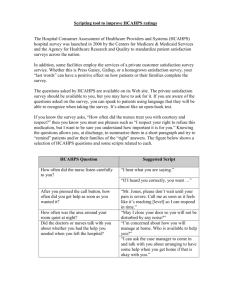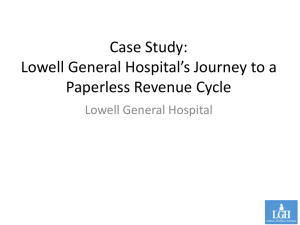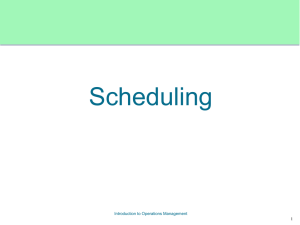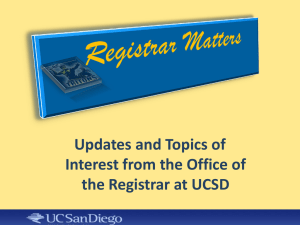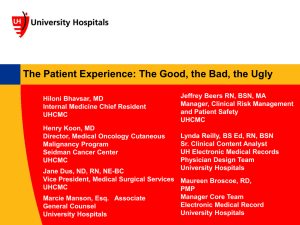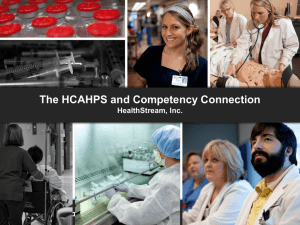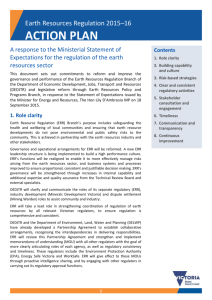Manage Your Message - National Association of Healthcare Access
advertisement
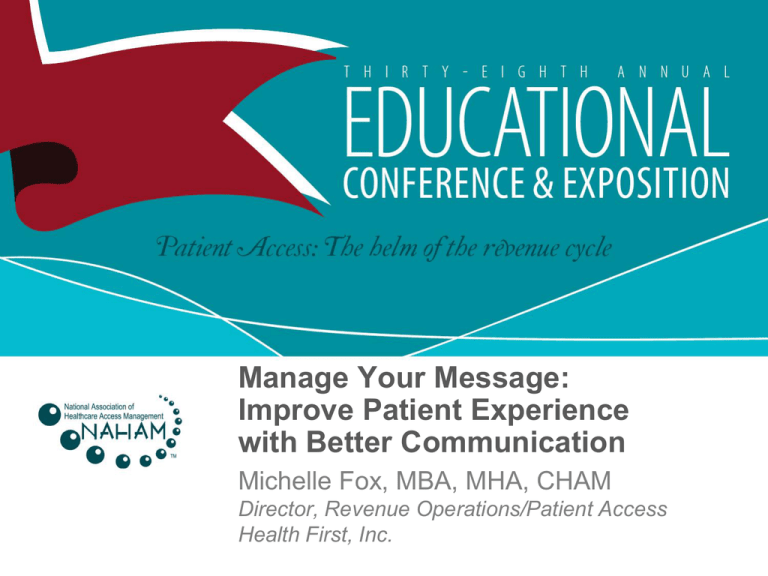
Manage Your Message: Improve Patient Experience with Better Communication Michelle Fox, MBA, MHA, CHAM Director, Revenue Operations/Patient Access Health First, Inc. Health First, Inc. • Located in Brevard County on Space Coast • 4 not-for-profit hospitals • 920 acute-care beds • Other services: • 4 outpatient diagnostic centers • 175+ Health First employed physicians • Health First Health Plans Learning Objectives 1. Define business processes that ensure streamlined access for patients. 2. Create proper clinical and financial expectations for patients prior to arrival. 3. Review patient communications for clear and accurate messaging. 4. Use records for quality assurance, training and productivity monitoring. The Patient Experience Imperative HCAHPS Scores & Payment • Since 2008: Hospitals requesting full payment for treatment to inpatients covered by Medicare & Medicaid required to report patient perception of care data using HCAHPS • Beginning in Oct 2012: Under Value-Based Purchasing, CMS may withhold up to 2-3% of reimbursements based on HCAHPS scores and other quality measures • Hospitals cover the difference Centers for Medicare & Medicaid Services, 42 CFR Parts 422 and 480; Medicare Programs; Hospital Inpatient Value-Based Purchasing Program So…What is Patient Experience? “The sum of all interactions, shaped by an organization’s culture, that influence patient perceptions across the continuum of care.” How is it Formed? “Comprised of every impression and encounter a patient (or family member) has with your health system. “Whether it's making a phone call for additional information, scheduling an appointment, or whether your website is easy to navigate, every interaction impacts patient perception.” The Patient Experience 2010 Survey of Senior Healthcare Leaders: What priority is the patient experience to your organization? Top 5 Priority 93% Business Imperative that Drives Referrals, Volume and More of a Priority Revenue as Much as Clinical in the Last Year Quality 80% *Source: August 2010 HealthLeaders Media online survey of senior healthcare leaders 72% A Positive Patient Experience A Negative Patient Experience Patient Experience & Profits According to Press Ganey, patient satisfaction and profits are positively correlated, and hospitals can increase profits by 2-5% by improving patient satisfaction. Perception of Care 3 of 4 patients rate hospital quality based on perception of care rather than objective measures. Source: Professional Research Consultants, National Consumer Perception Study, 2006. Perception & Clinical Satisfaction Satisfied with Billing Experience Unsatisfied with Billing Experience 93% Satisfied with Clinical 63% Satisfied with Clinical Source: “Study Shows Link between Patient Satisfaction with Billing Experience and Clinical Satisfaction,” Executive Insight, ©2011. Patient Complaints Recent study of 1,216 patient complaints from two Boston hospitals: • 19% identified unprofessional conduct • 17% reported poor provider-patient communication Source: Patient’s Voice, Healthcare Management Toolkit, 2011. 10 Most Common Patient Complaints Difficulty scheduling an appointment Long wait times Rude or uncaring staff Lack of coordination of care Poor/ineffective treatment Uncomfortable or unclean environment Billing problems Unprofessional conduct Poor patient-provider communication Unreturned calls HCAHPS & Communication The strongest predictor of overall HCAHPS scores is how patients rate provider communication skills. Source: Bavis and Fulton, Press Ganey Whitepaper, 2008. HCAHPS & Communication More than 50% of patients say that good communication is the #1 reason they chose a hospital or clinic. Source: Katzenbach Partners, 2007. Healthcare Consumer Survey (results based on phone interviews with 1,000+ patients) What This Means for Patient Access •Ease of Scheduling an appointment •Ease of Registration process •Waiting time in Registration •Staff was friendly and courteous Patient Access Touch Points Physician scripts Consents and authorizations Insurance benefits verification Prior authorization Notification of admission Patient out of pocket estimate Financial Counseling/Medicaid Eligibility Identify payer sources Communication Challenges We Faced Too much paper No proof of communication when disputed No way to monitor communication for QA No central storage for records Inefficiency, rework The Impact? Inefficiency Busy Lines Duplication Lost faxes Hold Time Complaints Denials Costbleeding Missed Revenue Our Solution: An EMR for Patient Access Electronic Revenue Record (ERR) Technology-based solution that documents all communication (voice, fax, and electronic) on the business side of patient care (with patients, payers, physicians and between providers). Records archived in a central repository and automatically indexed to the patient account for processing, routing and retrieval. Objectives Integrate Revenue Processes Centralize Scheduling Requests Capture Preregistration Data Document Authorization Data File Cabinet Computer Scanner Printer CD-ROM Tape Recorder DVD Memory Note Pad File Cabinet Computer Scanner Tape Recorder Memory Face-to-Face Conversations Printer CD-ROM DVD Note Pad Tools: Our Capture Methods Voice Fax Electronic Inbound Calls Inbound Faxes Web Pages Outbound Calls Outbound Faxes Emails Voice Mails Paper Documents Images, Documents Live Conversations Notifications Electronic Forms Central Record Storage ERR Features Web Tracking System Retrieval and Routing Electronic Revenue Record (ERR) SystemWide Access Index and Archive Date-andTime Stamp Electronic Revenue Record (ERR) Electronic Records Inbound Fax Records Outbound Fax Records Voice Records Voice Records Used to Streamline Workflow Scheduling Business Office …between departments Eligibility Patient Patient Discharge Authorization Continued Stay PreRegistration Registration …and for individual activities How ERR Supports Patient Experience • Scheduling • Precertification/Preregistration Process • Payment Estimates/POS Collections Scheduling…Right Place, Right Time Scheduling efficiency Record-sharing Off-site access • Route all scheduling to one fax number • Index records by department (Surgery, GI Lab, Cardiology, etc.) • Retrieve all records pertaining to patient • Reduce phone calls between departments • Monitor productivity remotely (pending scripts, calls) • Communicate with telecommuters Scheduling Results Centralized records to reduce calls, faxes and emails; filing and duplication Increased call volume by 20 calls/day Saved $60,000/year by eliminating 2 temporary positions Saved $7,200 on paper and toner supplies Clear, Accurate Communication • • • • • • Call recording Face-to-face communication QA reviews Training for schedulers Quality measures, competency reviews *Bonus: Behavior modification for physicians & clinical staff Call Monitoring: QA Scorecard Registration Process • Assure patient has received financial clearance. • Set expectations for what patient will encounter on the clinical side. • Remove worry; set minds at ease. • Remove mystery from registration process so patients aren’t surprised with copays and deductibles. • Good for organization and the patient Payment Estimates/POS Collections • Prepare patient’s out-of-pocket estimate when encounters are scheduled. • Record all communication to assure staff follow all protocols and communication is memorialized when needed for future discussions or disputes. • Monitor communication to ensure staff communicate clearly, accurately and ask the right questions in the right way. Benefits of an ERR Monitor communication records for quality and customer service Troubleshoot issues to improve quality assurance Modify behavior in patient, physician and staff interaction Results • • • • • • Customer service improvement Patient satisfaction Quality assurance Efficiency: no more printing and scanning Workflow between departments Staff support, satisfaction Conclusions • Communication impacts a patient’s perception of care more than any other area. • Technology is available to create an Electronic Revenue Record (ERR) of communication that surrounds the business side of patient care. • Capturing and monitoring communication provides valuable insight that can be used to improve patient experience. Questions? Michelle Fox Director Revenue Operations,Patient Access Health First, Inc. (321) 434-6017 michelle.fox@health-first.org
